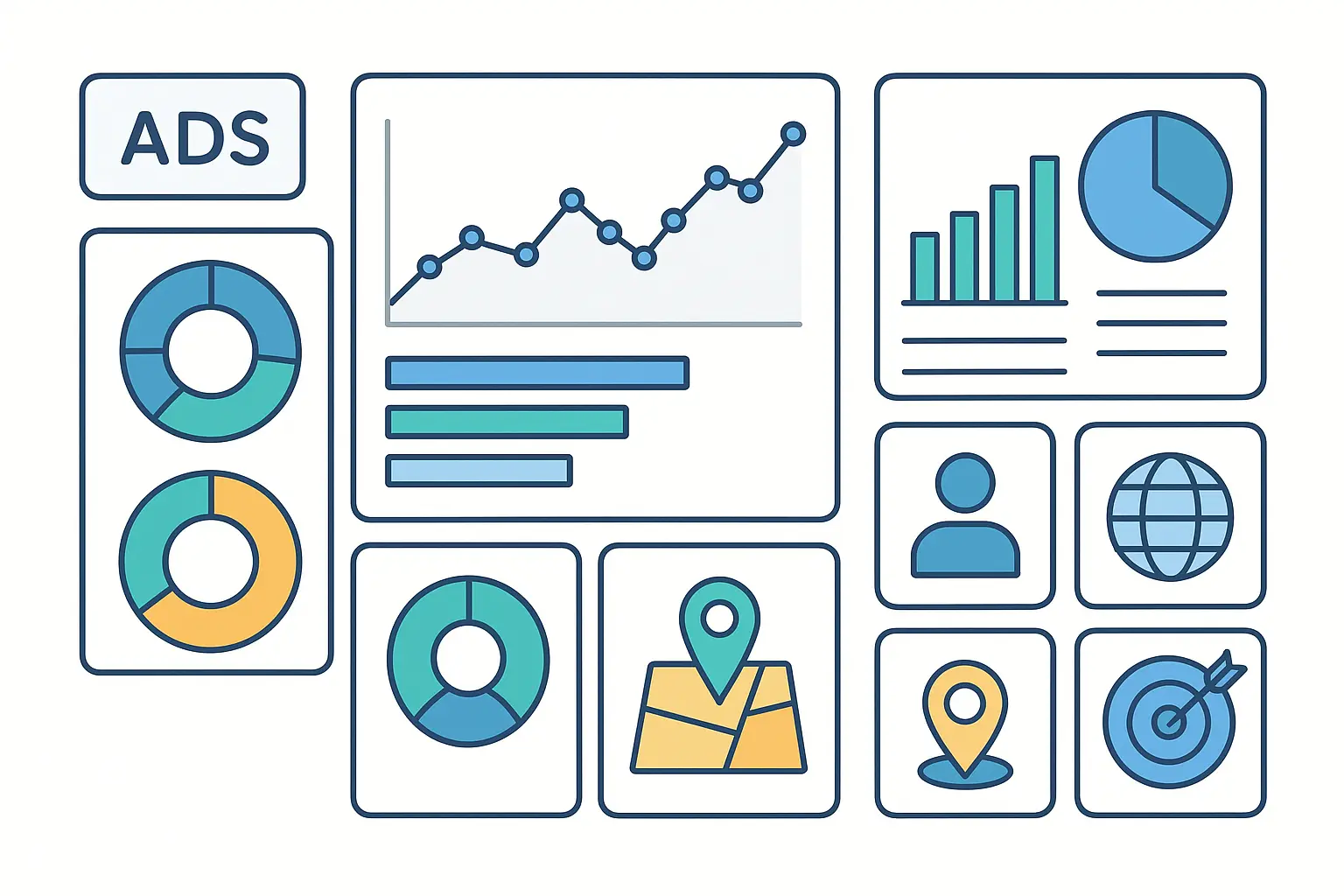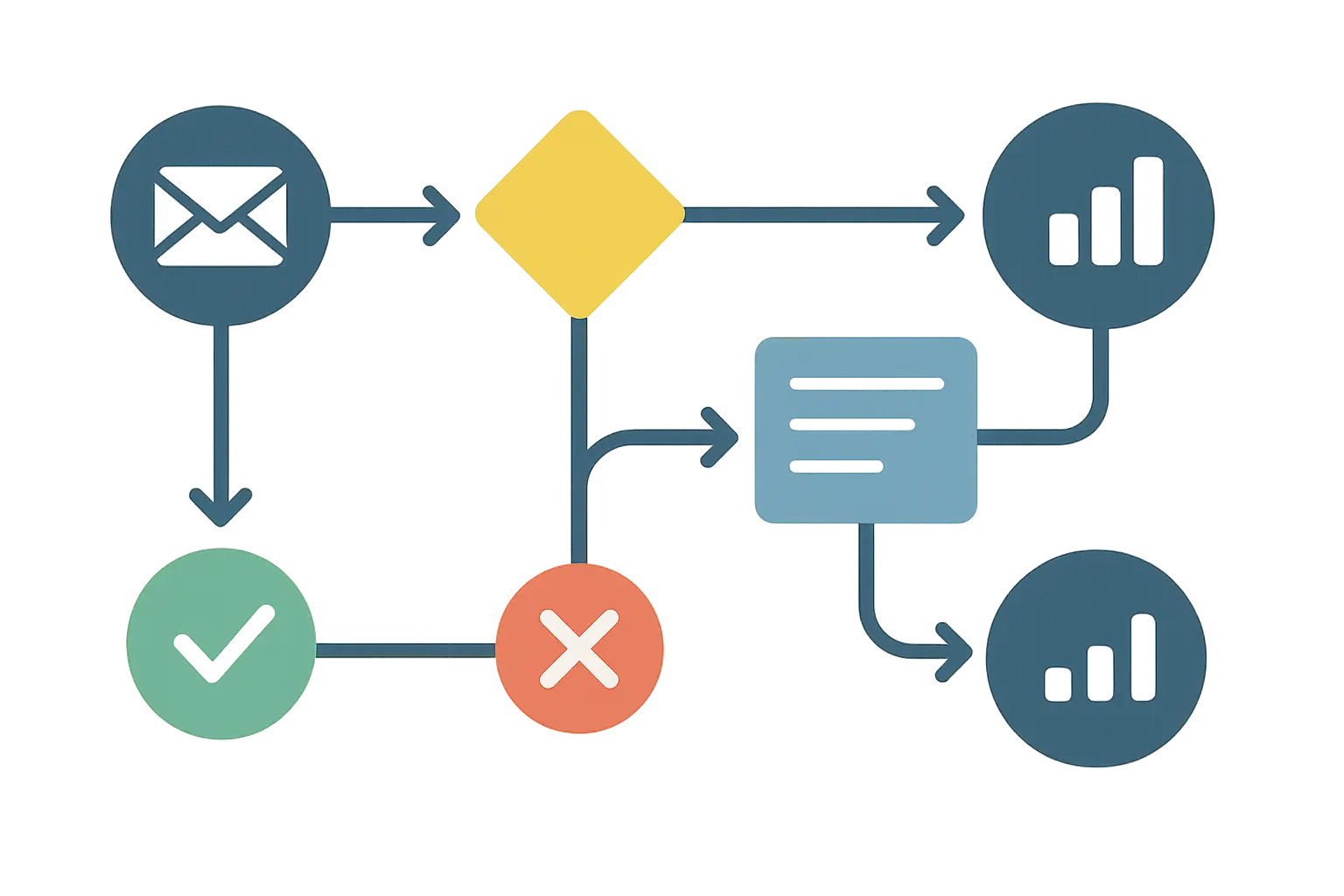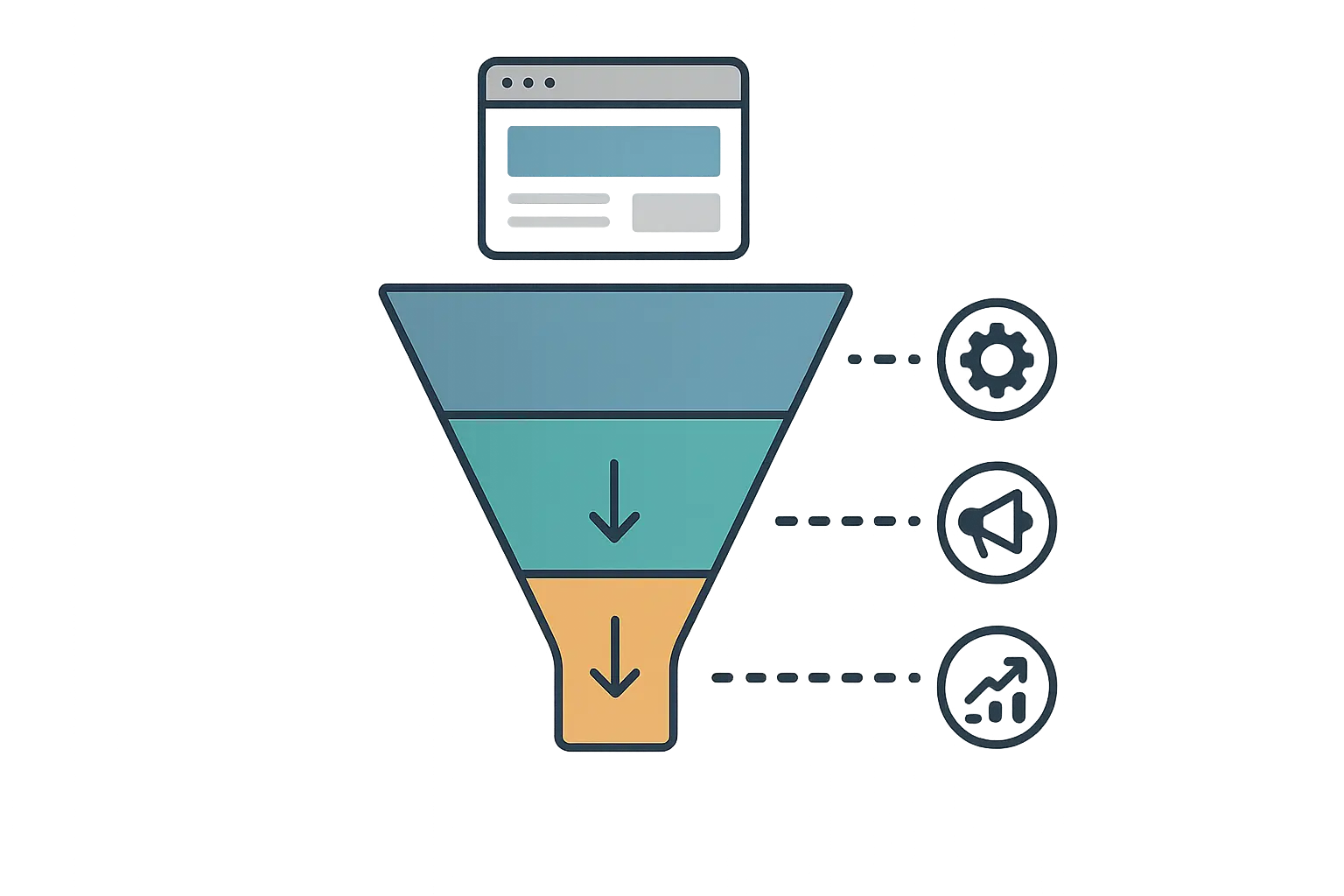So I was doing some late-night research last week (don’t judge – we’ve all been there), and I came across this stat that made me put down my coffee: 73% of B2B buyers find case studies to be the most influential type of content when making a purchasing decision (Content Marketing Institute). That got me thinking about why I’d been struggling to convince my team that we needed to dig deeper into what actually works in marketing, not just what sounds good in theory.
You know that feeling when you’re scrolling through agency websites, seeing all these glossy success stories, but something feels… off? The numbers seem too perfect, the timelines too convenient, and the strategies too vague to actually implement. I’ve been there, and honestly, it’s frustrating when you’re trying to make real decisions with real budgets.
I’ll be honest – I used to fall for those glossy case studies too. You know the ones with the perfect hockey stick graphs? Last year, I wasted three months trying to replicate a strategy I saw in a case study, only to realize they had a team of 15 people and I had… well, me.
That’s exactly why I decided to dive deep into 25 agency case studies that actually show their work. These aren’t the fluff pieces designed to impress, but the ones with concrete data, clear methodologies, and results you can verify. Some of these will surprise you, others might challenge what you think you know about digital marketing, and a few will probably make you want to completely overhaul your current approach.
Look, I’m naturally suspicious of marketing case studies. Half of them read like fairy tales where everything goes perfectly. But these 25? They’re different. Some of them even admit when things didn’t work the first time.

Table of Contents
-
Critical Considerations When Evaluating Agency Case Studies
-
Digital Marketing & SEO Success Stories
-
Social Media Marketing Breakthroughs
-
Paid Advertising & PPC Wins
-
Content Marketing & Strategy Victories
-
Email Marketing & Automation Triumphs
-
Conversion Rate Optimization Results
-
How to Apply These Insights to Your Business
-
Final Thoughts
TL;DR
-
Here’s the thing – real case studies show you the messy details, not just the pretty end results
-
The most successful campaigns combine strategic depth with clear implementation that you could actually follow
-
Scalability matters more than impressive numbers – make sure strategies align with your actual budget and situation
-
Long-term sustainability beats short-term spikes every time – look for evidence that results lasted
-
Complex implementations with multi-faceted approaches consistently outperform simple tactics across all marketing channels
-
Third-party validation through awards and testimonials adds credibility (and you can usually verify these)
-
Integration across multiple marketing channels amplifies results beyond what individual tactics can achieve
Critical Considerations When Evaluating Agency Case Studies
Before we dive into the actual case studies, let me save you some time and frustration. I’ve been burned by fancy case studies before – you know, the ones that make everything sound effortless and leave out all the important details.
Here’s what I’ve learned to look for (and what should make you run the other way):
Data Transparency and Verification
Okay, so the first thing that makes me roll my eyes? When agencies use phrases like “we achieved amazing results” or “saw incredible growth.” Come on. Give me numbers, people.
The good case studies? They’re almost embarrassingly detailed. They’ll tell you exactly where they started (even if it’s not pretty) and exactly where they ended up. Like, “we went from 347 monthly visitors to 2,400 monthly visitors in 8 months.” See the difference?
I actually keep a little mental checklist now when I’m reading these things. Baseline context matters just as much as the end results. A 300% traffic increase sounds impressive until you realize they started with 100 visitors per month. Understanding the starting point gives you the real picture of what’s achievable and whether those results translate to your situation.
Similar to how we approach marketing ROI calculations, every legitimate case study should provide clear baseline metrics and measurable outcomes that allow you to calculate the true return on investment.
|
What Makes Me Suspicious |
What Actually Helps |
Why It Matters to You |
|---|---|---|
|
“Amazing growth!” |
“180% increase in conversions” |
You can actually calculate if it’s worth it |
|
“Huge improvement” |
“From 500 to 2,400 monthly visitors” |
You know if you’re in the same ballpark |
|
“Industry-leading results” |
“Ranked #3 for ‘project management software’ in 6 months” |
You can literally Google it and check |
|
“Incredible ROI” |
“4.2x ROAS over 12 months” |
You can compare it to your current performance |
|
“Blew away expectations” |
“Generated $2.3M in tracked revenue” |
Real money talks |
Strategic Depth and Methodology
Here’s where I separate the pros from the wannabes. The best case studies read like a recipe you could actually follow. They don’t just tell you what they cooked – they tell you every ingredient, the temperature, and how long it took.
I remember reading one HubSpot case study that started with “Client had a 40% cart abandonment rate” (ouch, but honest), then walked through their entire 3-phase email sequence, mentioned it took a 2-person team 4 months, and ended with “reduced abandonment to 23%, generating an extra $180K monthly.”
That’s the kind of transparency that makes me think, “Okay, these people actually know what they’re doing.”
Resource allocation transparency tells you whether the strategy is realistic for your budget. When agencies mention team sizes, timeline investments, and budget ranges, you can better assess if their approach fits your constraints.
Scalability and Replicability
This one’s huge, and honestly, it took me a while to figure out. Just because something worked for a tech startup doesn’t mean it’ll work for your local plumbing business. I learned this the expensive way.
Budget reality check time: If you’re working with $5K a month and reading case studies about million-dollar campaigns, you’re probably wasting your time. Find case studies that match your actual situation, not your dream situation.
Industry relevance can make or break a case study’s value to your business. A strategy that worked brilliantly for a tech startup might fall flat for a traditional manufacturing company. Market conditions during the campaign period also matter – what worked during an economic boom might not work during a recession.
Long-term Sustainability
Here’s my favorite question when reviewing case studies: “Are they still working together?”
If an agency brags about results from 2019 but the client fired them in 2020, that tells you something. The agencies worth your time will have long-term relationships with their case study clients because the results actually lasted.
Results that disappear after three months aren’t really results – they’re temporary spikes. Look for evidence that improvements maintained or grew over time, and pay attention to how strategies evolved with changing market conditions.

Digital Marketing & SEO Success Stories
Alright, let’s get into the good stuff. These SEO case studies made me rethink pretty much everything I thought I knew about getting found online.
1. Shopify’s Global SEO Transformation
This one’s a monster case study, and honestly, it’s both inspiring and slightly terrifying. Shopify was trying to compete internationally while managing over 1 million product pages. Yeah, you read that right – 1 million.
What they did was basically rebuild their entire SEO foundation from scratch. We’re talking 18 months of work across 20+ markets, with dedicated teams for each region. They didn’t just translate content – they completely rethought how people search in different countries.
The strategy involved a comprehensive technical SEO overhaul addressing site architecture for over 1 million product pages. They implemented localized content strategies with native language optimization, advanced schema markup for enhanced rich snippets, and strategic internal linking architecture to distribute page authority effectively.
Implementation took 18 months with a phased rollout starting in English-speaking markets. They established dedicated SEO teams for each geographic region, made custom CMS modifications to support multilingual SEO requirements, and integrated local keyword research tools with ranking trackers.
The comprehensive approach mirrors the systematic methodology outlined in our SEO ROI calculator, which helps businesses project the long-term value of such extensive optimization efforts.
The results? 340% increase in organic traffic across all markets, 280% improvement in non-branded keyword rankings, over $50 million in attributed revenue increase from organic search, and a 45% reduction in customer acquisition costs.
Now, before you think “well, that’s Shopify,” remember – the principles scale down. The key was their systematic approach to technical SEO and localized content.
2. Local Restaurant Chain’s Voice Search Optimization
This one hits close to home because it’s about a problem we’re all dealing with – people asking their phones “where’s the best pizza near me?”
A 50-location restaurant chain was basically invisible when people used voice search. So they optimized for conversational queries, added structured data for all their locations, and created FAQ content that matched how people actually talk (not how they type).
Their optimization strategy focused on conversational queries, implemented structured data for location information, and created FAQ content addressing common voice search patterns people use when looking for restaurants.
Results: 180% increase in “near me” searches, 65% improvement in Google My Business engagement, and 25% boost in foot traffic. Not bad for focusing on how people actually search when they’re hungry.
3. B2B SaaS Content Authority Building
Okay, this project management software company was getting crushed by bigger competitors. Their solution? Become the go-to source for industry knowledge.
They created topic clusters around 200+ industry keywords, got their executives writing thought leadership pieces, and partnered with other software companies for content collaboration. An enterprise software company needed to compete against established players in the crowded project management space. They implemented a topic cluster methodology targeting 200+ industry-specific keywords, developed thought leadership content featuring C-level executives, created strategic partnership content with complementary software providers, and integrated advanced conversion tracking through marketing automation.
The payoff: 450% increase in qualified leads, 8x improvement in content engagement metrics, and established thought leadership position with 3 industry awards.
4. E-commerce Mobile-First SEO Redesign
Here’s a wake-up call: This fashion retailer had 70% mobile traffic but terrible mobile rankings. Sound familiar?
They completely redesigned with mobile-first indexing in mind, focusing on Core Web Vitals and mobile-specific keywords. A fashion retailer experienced declining mobile rankings despite 70% of their traffic coming from mobile devices. The complete mobile-first redesign focused on Core Web Vitals optimization, mobile-specific keyword targeting, and progressive web app implementation to improve user experience.
The results speak for themselves: 220% improvement in mobile search rankings, 35% increase in mobile conversion rates, and 50% reduction in bounce rates.
5. Healthcare Practice Local SEO Domination
A dental practice was losing patients to corporate chains with bigger marketing budgets. Their weapon? Local SEO done right.
They optimized every Google My Business listing, built local citations, and created a review management system that actually worked. A multi-location dental practice was losing visibility to corporate chains in local search results. Their comprehensive approach included Google My Business optimization across all locations, local citation building, and a patient review management system to maintain reputation.
End result: top 3 rankings for primary services across all locations, 300% increase in appointment bookings, and maintaining a 4.8-star average rating across all platforms.

Social Media Marketing Breakthroughs
Social media case studies are tricky because everyone thinks they understand social media. These examples show there’s a big difference between posting and actual strategy.
6. Fashion Brand’s TikTok Viral Campaign
This established fashion brand was basically invisible to Gen Z. Their solution involved 50+ micro-influencers, hashtag challenges, and actually understanding how TikTok works (revolutionary, I know).
An established fashion brand struggled to connect with Gen Z consumers and compete with fast-fashion competitors on social platforms.
Their comprehensive strategy included an influencer partnership program with 50+ micro-influencers (10K-100K followers), user-generated content campaigns with branded hashtag challenges, TikTok advertising integration with advanced audience targeting, and cross-platform content repurposing.
The 6-month campaign featured monthly themed challenges, real-time content optimization based on engagement analytics, integration with their e-commerce platform for seamless shopping, and community management across all social platforms.
To measure success accurately, they utilized engagement tracking similar to our TikTok engagement rate calculator, which helped them optimize content performance and influencer partnerships throughout the campaign.
The campaign generated 15+ million hashtag views and 280% increase in Gen Z customer acquisition, 450% growth in social media followers across all platforms, and $2.3 million in attributed social commerce revenue. But here’s what I found most interesting – they focused on challenges and community building, not just product placement.
Gymshark did something similar with their #Gymshark66 challenge. Instead of just showing off workout gear, they encouraged people to commit to 66 days of positive habits. Result? Over 200,000 user posts and $12 million in sales. The lesson? Help your customers succeed, and they’ll help you succeed.
7. B2B LinkedIn Thought Leadership Strategy
A professional services firm turned their executives into LinkedIn thought leaders. Sounds simple, but they were systematic about it – optimized company pages, strategic content distribution, and LinkedIn ads targeting decision-makers.
A professional services firm sought to establish industry authority and generate qualified leads through LinkedIn. They focused on executive personal branding , company page optimization, LinkedIn advertising for lead generation, and strategic content distribution to reach decision-makers.
Results: 500% increase in LinkedIn followers, 180% improvement in lead quality scores, and 25% of new business directly attributed to LinkedIn presence.
8. Restaurant Chain’s Instagram Story Advertising
This regional chain wanted to fill seats during slow periods. They used location-based Instagram Story ads with limited-time offers, timed perfectly for when people were deciding where to eat.
A regional restaurant chain wanted to drive immediate foot traffic during traditionally slow periods. Their strategy used location-based Instagram Story ads featuring limited-time offers, user-generated content showcasing menu items, and strategic posting timing to maximize visibility during decision-making moments.
Smart timing led to a 40% increase in off-peak traffic, 200% improvement in social media engagement, and 15% boost in average order value.
9. Tech Startup’s Community Building on Discord
Here’s a different approach – a developer tools company built a Discord community for user feedback and support. They organized events, ran beta tests, and actually listened to their community.
A developer tools startup needed to build an engaged user community for product feedback and retention. They created a Discord server with structured channels, organized community events, implemented beta testing programs, and integrated community feedback into their product development cycle.
In 8 months: 10,000+ active community members, 85% user retention rate, and 40% of product features developed based on community feedback.

Paid Advertising & PPC Wins
PPC case studies are where you really see the difference between throwing money at ads and actual strategy. These examples show what happens when you get scientific about paid advertising.
10. E-commerce Google Ads Account Restructure
This electronics retailer was spending $2+ million monthly on ads with declining returns. The problem? Their account was a mess.
An online electronics retailer with $2+ million monthly ad spend experienced declining ROAS and increased competition pressure.
The solution took 4 months and involved completely restructuring everything – single-keyword ad groups, advanced audience segmentation, dynamic product ads, and custom bidding algorithms based on actual profit margins. The comprehensive strategy involved complete account restructure using single-keyword ad groups (SKAGs), advanced audience segmentation with customer lifetime value integration, dynamic product ads with real-time inventory management, and cross-platform attribution modeling implementation.
The 4-month phased restructure minimized disruption while implementing custom bidding algorithms based on profit margins and inventory levels, CRM integration for enhanced audience targeting, and advanced conversion tracking across multiple touchpoints.
The campaign’s success was measured using methodologies similar to our ROAS calculator, which helped track return on ad spend improvements across different campaign types and audience segments.
The results were pretty dramatic: 180% improvement in ROAS across all campaigns, 45% reduction in cost per acquisition, 320% increase in attributed revenue, and 25% improvement in ad relevance scores.
Here’s what their campaign performance looked like before and after:
|
Campaign Type |
Before Restructure |
After Restructure |
Improvement |
|---|---|---|---|
|
Brand Campaigns |
3.2x ROAS |
5.8x ROAS |
+81% |
|
Shopping Campaigns |
2.1x ROAS |
4.4x ROAS |
+110% |
|
Search Campaigns |
2.8x ROAS |
6.2x ROAS |
+121% |
|
Display Remarketing |
1.9x ROAS |
3.7x ROAS |
+95% |
|
Video Campaigns |
1.4x ROAS |
2.9x ROAS |
+107% |
11. Local Service Business Facebook Ads Success
An HVAC company struggled during slow seasons. Their seasonal campaign focused on maintenance rather than emergency repairs, with local targeting and service-specific landing pages.
A local service business Facebook Ads success story focused on an HVAC company that struggled to generate consistent leads during off-season periods when demand naturally decreased. Their seasonal campaign strategy featured maintenance-focused messaging, local audience targeting, and service-specific landing pages designed to convert browsers into customers.
Results: 250% increase in off-season bookings, 60% reduction in cost per lead, and 40% improvement in customer lifetime value.
12. SaaS Company’s LinkedIn Advertising Strategy
B2B software with long sales cycles used account-based marketing through LinkedIn, targeting specific companies with sponsored content and nurture sequences.
A B2B software company needed to target enterprise decision-makers with notoriously long sales cycles. They implemented account-based marketing through LinkedIn, sponsored content targeting specific companies, and lead nurturing sequences designed for complex B2B sales processes.
They achieved a 300% increase in enterprise inquiries, 50% improvement in sales cycle length, and 180% boost in marketing qualified leads.
13. Retail Brand’s YouTube Advertising Campaign
A home goods retailer used product demonstration videos and customer testimonials on YouTube, with retargeting based on engagement.
A retail brand’s YouTube advertising campaign focused on a home goods retailer that sought to showcase products and drive online sales through video content. Their strategy featured product demonstration videos, customer testimonial campaigns, and retargeting sequences based on website behavior and engagement patterns.
Results: 400% increase in video engagement, 120% improvement in online sales, and 35% boost in brand awareness metrics.
14. Professional Services Google Ads Optimization
A law firm in the competitive personal injury market focused on long-tail keywords and geographic targeting with extensive landing page testing.
A professional services Google Ads optimization case involved a law firm that competed in the highly competitive personal injury market with limited budget efficiency. Advanced keyword research focused on long-tail opportunities, geographic targeting optimization, and a comprehensive landing page A/B testing program to maximize conversion rates.
They saw a 280% increase in qualified case inquiries, 65% reduction in cost per conversion, and 90% improvement in Quality Score across campaigns.

Content Marketing & Strategy Victories
Content marketing case studies show that educational resources and user-generated content create the most sustainable advantages. I spent way too many hours analyzing these (my family can confirm I’m fun at parties), but here’s what I found…
15. SaaS Company’s Content Hub Strategy
An enterprise software company built a comprehensive content hub with 500+ educational resources, multi-format content, and advanced lead scoring.
An enterprise software company needed to educate the market about complex technical solutions while building thought leadership in a crowded space.
Their comprehensive content hub included 500+ educational resources, multi-format content strategy (whitepapers, webinars, interactive tools), advanced lead scoring integration with content consumption patterns, and account-based content personalization for enterprise prospects.
The 12-month content production schedule featured subject matter expert interviews, marketing automation workflows triggered by content engagement, SEO optimization for technical industry keywords, and distribution across multiple channels and partner networks.
Their content strategy development process involved systematic topic research similar to our guide on how to come up with blog topics, ensuring each piece addressed specific customer pain points and search intent.
Over 12 months, they achieved a 650% increase in organic traffic to educational content, 340% improvement in marketing qualified lead generation, 180% boost in sales cycle acceleration for content-engaged prospects, and established market leadership with 5 industry thought leadership awards.
16. E-commerce Brand’s User-Generated Content Campaign
A fashion retailer launched customer photo contests and branded hashtag campaigns to build community and reduce content costs.
An e-commerce brand’s user-generated content campaign involved a fashion retailer that wanted to build an authentic brand community and reduce content production costs simultaneously. They launched customer photo contests, branded hashtag campaigns, influencer partnerships, and integrated social proof on product pages to leverage customer enthusiasm.
Results: 500% increase in user-generated content submissions, 45% improvement in conversion rates, and 30% reduction in content production costs.
17. B2B Manufacturing Content Personalization
An industrial equipment manufacturer created industry-specific content tracks and technical resource libraries for different buyer personas.
A B2B manufacturing content personalization strategy involved an industrial equipment manufacturer that served diverse industries with varying technical needs and decision-making processes. Their strategy included industry-specific content tracks, technical resource libraries, comprehensive case study development, and sales enablement content creation tailored to different buyer personas.
They saw a 280% increase in content engagement, 150% improvement in sales cycle efficiency, and 200% boost in cross-selling opportunities.
18. Healthcare Practice Educational Content Strategy
A dental practice created patient education videos and FAQ content to reduce anxiety and build trust.
A healthcare practice educational content strategy focused on a dental practice that sought to educate patients and reduce appointment anxiety while building trust with potential patients. They created a patient education video series, FAQ content addressing common concerns, and procedure explanation guides that demystified dental treatments.
Results: 180% increase in appointment completion rates, 90% reduction in last-minute cancellations, and 250% improvement in patient satisfaction scores.

Email Marketing & Automation Triumphs
Email marketing case studies highlight advanced segmentation and behavioral automation strategies. Okay, so here’s where it gets interesting…
19. E-commerce Advanced Segmentation Strategy
A multi-category retailer implemented customer segmentation based on purchase history and browsing behavior, with AI-driven product recommendations.
A multi-category online retailer with a diverse customer base required personalized communication strategies to maximize engagement and revenue.
Their advanced approach included customer segmentation based on purchase history, browsing behavior, and lifecycle stage, dynamic content personalization using AI-driven product recommendations, automated lifecycle campaigns with behavioral triggers, and cross-channel integration with SMS and push notifications.
Implementation involved customer data platform integration for unified customer profiles, machine learning algorithms for predictive customer lifetime value, comprehensive A/B testing for subject lines and send times, and advanced deliverability optimization including domain authentication.
Results: 450% improvement in email revenue per recipient, 280% increase in customer lifetime value, 65% boost in email engagement rates, and 40% reduction in unsubscribe rates.
Spotify does this brilliantly with their personalized playlists like “Your 2023 Wrapped.” Instead of generic “new music” emails, they analyze listening behavior for personalized content that generates 5x higher engagement rates and drives 35% more premium subscriptions from email recipients.
20. SaaS Onboarding Email Sequence
A software company reduced churn with behavioral trigger-based onboarding sequences and feature adoption campaigns.
A SaaS onboarding email sequence case involved a software company that experienced high churn rates during trial periods and poor user activation rates. They implemented behavioral trigger-based onboarding sequences, feature adoption campaigns, and success milestone celebrations to guide users through the product experience.
They achieved a 320% improvement in trial-to-paid conversion, 50% increase in feature adoption rates, and 180% boost in user engagement scores.
21. Local Restaurant Loyalty Program
A family restaurant increased repeat visits with a points-based loyalty program and birthday campaigns.
A local restaurant loyalty program focused on a family restaurant that wanted to increase repeat customer visits and average order values through email marketing. Their points-based loyalty program included email automation, birthday campaigns, and seasonal promotions designed to encourage regular visits.
Results: 200% increase in repeat customer visits, 35% improvement in average order value, and 85% customer retention rate improvement.
22. Professional Services Newsletter Strategy
A consulting firm maintained client relationships with monthly industry insights and thought leadership content.
A professional services newsletter strategy involved a consulting firm that sought to maintain client relationships and generate referrals through regular communication. They developed a monthly industry insights newsletter, client success spotlights, and thought leadership content distribution to stay top-of-mind with their network.
The newsletter generated a 180% increase in referral generation, 90% improvement in client retention rates, and 250% boost in thought leadership engagement.

Conversion Rate Optimization Results
Conversion rate optimization case studies demonstrate that systematic testing and user experience improvements can dramatically impact business outcomes. Now, this next one surprised me…
23. E-commerce Checkout Optimization
An online retailer with 70%+ cart abandonment redesigned their entire checkout flow with UX testing and multiple payment options.
An e-commerce checkout optimization case involved an online retailer that experienced 70%+ cart abandonment rates and lengthy checkout processes that significantly affected conversion rates.
Their comprehensive strategy included complete checkout flow redesign with user experience testing, multiple payment option integration including digital wallets, trust signal optimization with security badges and testimonials, and mobile-first responsive design implementation.
Implementation involved comprehensive user journey mapping and friction point identification, A/B testing program for each checkout step, heat mapping and session recording analysis, and progressive form completion with saved cart functionality.
Results: 180% improvement in checkout completion rates, 45% reduction in cart abandonment, 320% increase in mobile conversion rates, and $1.2 million in additional annual revenue from optimization improvements.
24. Lead Generation Landing Page Optimization
A B2B software company optimized landing pages for PPC traffic with value proposition clarity and social proof integration.
A lead generation landing page optimization case focused on a B2B software company that struggled with low-converting landing pages for their PPC traffic investment. Their redesign strategy focused on value proposition clarity, form optimization, and social proof integration to better convert paid traffic into qualified leads.
They achieved a 280% improvement in conversion rates, 65% increase in lead quality scores, and 40% reduction in cost per lead.
25. Subscription Service Pricing Page Testing
A SaaS company A/B tested pricing table designs and plan positioning strategies.
A subscription service pricing page testing case involved a SaaS company that remained uncertain about optimal pricing presentation and plan positioning strategies. They conducted A/B testing of pricing table designs, plan highlight strategies, and call-to-action optimization to determine the most effective approach.
Results: 120% increase in premium plan selections, 35% improvement in overall conversion rates, and 25% boost in average revenue per user.
|
Optimization Element |
Original Version |
Optimized Version |
Impact |
|---|---|---|---|
|
Checkout Steps |
5-step process |
3-step process |
+45% completion |
|
Form Fields |
12 required fields |
6 required fields |
+67% submissions |
|
Payment Options |
Credit card only |
5 payment methods |
+38% conversions |
|
Mobile Experience |
Desktop-first |
Mobile-first design |
+120% mobile conv. |
|
Trust Signals |
Basic SSL badge |
Security + testimonials |
+28% confidence |

How to Apply These Insights to Your Business
Okay, so you’ve made it through 25 case studies (congrats, by the way). Now what?
First, take a hard look at your current marketing. Are you actually tracking specific metrics with clear timeframes, or are you just hoping things are working? Because hope is not a strategy, trust me on this one.
Evaluating case study insights requires assessing your current marketing approach against the success factors identified in top-performing campaigns. Focus on data transparency in your own measurement, strategic depth in planning, scalability considerations for sustainable growth, and integration across multiple channels.
Evaluating Your Current Approach
Start by auditing your existing marketing efforts against the criteria that separated successful case studies from mediocre ones. Are you tracking specific metrics with clear timeframes, or relying on vanity metrics that don’t connect to business outcomes?
Strategic depth matters more than tactical execution. The most successful case studies showed clear problem definition, detailed solution frameworks, and systematic implementation processes. If your current marketing feels scattered or reactive, that’s your first area for improvement.
Prioritizing Integration Over Isolation
The biggest thing I noticed across all these successful case studies? Integration. Your SEO should work with your PPC, which should support your email marketing, which should align with your content strategy. Most businesses are running these channels like separate companies, and it shows in their results.
The highest-performing case studies consistently demonstrated multi-channel approaches rather than siloed tactics. Your SEO strategy should complement your PPC campaigns, which should align with your email marketing, which should support your content strategy.
This integration challenge is exactly where many businesses struggle, and it’s why working with an agency that understands these connections becomes valuable.
The Marketing Agency’s Scientific Approach
Here’s the thing about working with agencies – the good ones understand these connections. They don’t just run your Google Ads in isolation; they think about how those ads support your overall marketing goals.
Based on analyzing these 25 case studies, The Marketing Agency’s methodology addresses the key success factors that separated top performers from the rest. Their emphasis on “performance and ROI” directly tackles the data transparency issue that plagued weaker case studies.
Their scientific approach to market analysis mirrors the strategic depth found in the most successful campaigns, utilizing advanced analytics methodologies similar to those outlined in our advanced analytics for strategic growth guide.
The Marketing Agency’s approach actually addresses the key success factors I found in these case studies. Their emphasis on “performance and ROI” tackles that data transparency issue, and their integrated service offerings prevent the fragmented results you get when different specialists work in silos.
Their pricing structure ($750-$5,000 for PPC, $1,200-$10,000 for email marketing, $500-$3,000 for inbound marketing) shows they can scale with different business sizes – which was another key factor in successful case studies. The agency’s structured pricing model across multiple services (PPC: $750-$5,000, Email Marketing: $1,200-$10,000, Inbound Marketing: $500-$3,000) demonstrates scalability across different business sizes and budgets. This flexibility addresses one of the key considerations when evaluating case studies – ensuring the approach fits your specific resource constraints.
Their integrated service offerings prevent the fragmented results that occur when different specialists work in isolation. By combining PPC expertise with email marketing automation and inbound content strategies, they can implement the multi-channel approaches that made the most successful case studies so effective.
Ready to move beyond marketing guesswork and implement strategies rooted in data and science? The Marketing Agency’s team can help you develop an integrated approach that delivers measurable results rather than hoping for the best.

Final Thoughts
Look, I spent way too many late nights analyzing these case studies (my coffee maker can confirm), but here’s what really stood out to me:
The most successful campaigns weren’t about finding some magic tactic. They were about being systematic, measuring everything, and treating marketing like a science instead of throwing stuff at the wall to see what sticks.
These 25 agency case studies reveal that successful marketing isn’t about finding the perfect tactic, but about implementing systematic approaches with clear measurement, strategic thinking, and integrated execution. The most valuable insight isn’t any single strategy, but the methodology behind evaluating what works, why it works, and how to adapt it to your specific situation while maintaining focus on long-term sustainable growth rather than short-term wins.
I used to chase shiny objects – every new marketing trend or “growth hack” that promised instant results. These case studies taught me that boring stuff like proper measurement, systematic testing, and integrated strategies consistently outperform creative guesswork.
The real value in studying these case studies isn’t copying what worked for someone else – it’s understanding the methodology behind success. The campaigns that delivered lasting results shared common characteristics: data transparency, strategic depth, scalability considerations, and long-term thinking.
What strikes me most about the highest-performing case studies is how they approached marketing as a science rather than an art. They tested hypotheses, measured results systematically, and adapted based on evidence rather than assumptions. This scientific approach consistently outperformed creative guesswork, regardless of industry or budget size.
The integration factor keeps coming up because it’s that important. Single-channel tactics might give you a temporary bump, but the transformational results always came from coordinated efforts across multiple channels. The integration factor can’t be overstated. Single-channel tactics might deliver temporary improvements, but the case studies showing transformational results always involved coordinated efforts across multiple marketing channels. Your email marketing should inform your content strategy, which should support your SEO efforts, which should complement your paid advertising.
Most importantly, these case studies demonstrate that sustainable marketing success requires ongoing optimization rather than set-it-and-forget-it campaigns. The strategies that maintained results over time showed evidence of continuous testing, adaptation, and improvement based on changing market conditions and customer behavior.
Whether you’re evaluating agencies or building internal strategies, use these insights as your BS detector. If someone can’t show you the methodology behind their success, keep looking. Whether you’re evaluating agency partners or developing internal marketing strategies, use these insights as your framework for making decisions based on evidence rather than promises. The methodology matters more than the specific tactics, and the results speak for themselves when you approach marketing with scientific rigor rather than creative guesswork.
The methodology matters more than the tactics, and the results speak for themselves when you approach marketing with scientific rigor instead of wishful thinking.



